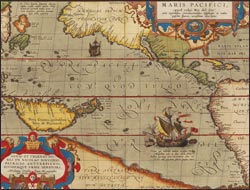The printing of engravings required a specialized “rolling press,” so-named because a plank, carrying an inked copper plate together with a sheet of paper, passed through the press by means of rollers. Initially, regional craft traditions determined the mapmaker’s choice between the intaglio process of copperplate engraving and the relief process of the woodcut, but, by the mid-16th century, the malleable metal predominated. Copper could be hammered into large plates, more finely incised, and more readily revised. The resulting detailed engraving produced a commodity that appealed to the tastes of the increasing number of customers with the interest, knowledge, and money to purchase maps.
Explore Copperplate Engraving
Maris Pacifici (quod vulgò Mar del Zur) cum regionibus circumiacentibus ...
As the printed map evolved from a scholarly tool to an article of consumption, the printer-publisher acquired a greater role in determining its appearance. The Antwerp printer Ortelius began his career as a map colorist and appreciated the qualities of craftsmanship that helped sell maps. He innovated the idea of the atlas--offering a bound volume of the most recent and accurate work of cartographers, all engraved in a uniform format and artfully embellished--which made him the most commercially successful map publisher of his time.

![[Map of southeastern North America] from Descriptionis Ptolemaicae augmentum sive Occidentis …](/exhibits/onthemap/media/thumbs/16_Wytfliet_p176_thumb.jpg)